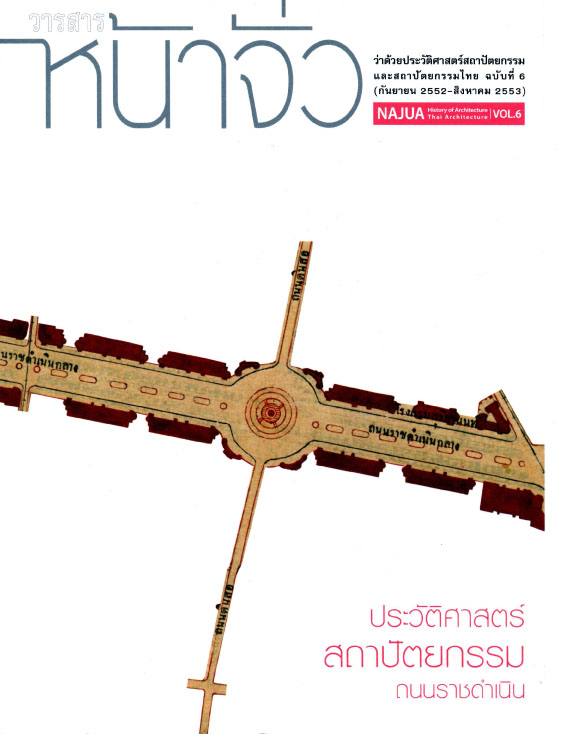การจัดการ “พื้นที่เมือง” เพื่อสร้าง “พื้นที่ประเทศไทย” ทศวรรษ 2500 ส่วนที่ 2 The Management of “Urban Space” to produce “Space of Thailand” around 1960’s Part 2
Main Article Content
Abstract
บทคัดย่อ
การเปลี่ยนแปลงที่สำคัญในทศวรรษ 2500 ได้แก่ การจัดการ “พื้นที่เมือง” เพื่อสร้างความเป็นเอกภาพของพื้นที่ระดับประเทศที่ได้รับการสานสร้างจากพื้นที่ต่างๆ เช่น พื้นที่ทางกายภาพ พื้นที่ทางสังคม และพื้นที่ทางความคิด พื้นที่ระดับประเทศในบทความนี้เรียกว่า “พื้นที่ประเทศไทย” โดยให้ความสำคัญกับการพิจารณาผ่าน “พื้นที่ทางกายภาพ” ในมุมหนึ่งเราอาจเห็นได้ว่ารัฐบาลเผด็จการทหารอาจเปี่ยมล้นไปด้วยอำนาจทั้งในทางตรงและทางอ้อม แต่แล้วปฏิบัติการทางอำนาจรัฐกลับไม่มีอำนาจอย่างเข้มข้นจริงจังที่จะสามารถจัดพื้นที่ได้อย่างถึงที่สุด การวางรากฐานการจัดการเมืองที่แม้จะได้รับการสนับสนุนทางวิชาการจากสหรัฐอเมริกากลับไม่ได้รับการเลือกมาใช้ในสังคมไทย ผิดกับการนำเข้าเทคโนโลยีด้านอื่นๆ ไม่ว่าจะเป็นในทางเศรษฐศาสตร์ รัฐศาสตร์ วิทยาศาสตร์ประยุกต์แขนงต่างๆ การจัดการเมืองจึงติดเพดานอยู่ที่เงื่อนไขบางประการของสังคมไทย ในทางตรงกันข้ามแทนที่ระบบการจัดการเมือง และพื้นที่ทางกายภาพระดับประเทศที่จะสร้างกรอบการเติบโตของเมืองและการเชื่อมต่อระหว่างกันก็ถูกผลักให้เป็นภาระอัตวินิจฉัยของข้าราชการประจำที่ไม่ได้มีความเชี่ยวชาญทางกายภาพ หากแต่ตัดสินใจด้วยสัญชาติญาณอย่างข้าราชการกระทรวงมหาดไทย อย่างนายอำเภอ ปลัดอำเภอ ฯลฯ หรือไม่ก็ถูกกำหนดด้วยนโยบายต่อต้านคอมมิวนิสต์ที่เร่งรัดสร้างโครงสร้างพื้นฐานของพื้นที่ชนบทเพื่อหวังจูงใจชาวชนบท และสร้างทัศคติที่ดีต่อรัฐ ไม่เพียงเท่านั้นการจัดการพื้นที่เมืองยังมีเพดานการใช้อำนาจทางวัฒนธรรมติดอยู่ด้วย ก็คือการติดกรอบอยู่กับสถาบันหลักของชาติทั้งยังมีความเกี่ยวข้องเชื่อมโยงกับอำนาจทุนในเมืองอีกด้วย
อย่างไรก็ตามอำนาจของรัฐในการจัดการพื้นที่เมืองแม้จะมีอยู่จำกัดในทางหนึ่ง แต่อำนาจนั้นก็มิได้หายไปไหน กลับปรากฏอยู่ที่การปฏิบัติการในเชิงปริมาณมากกว่ามิติในเชิงระบบ ซึ่งความลักลั่นดังกล่าวได้ส่งผลต่อปัญหาการจัดการเมืองทั่วประเทศมาจนถึงทุกวันนี้
Abstract
The crucial change in 1960’s is the management of “urban space” to integrate the national space which can be identified in 3 kinds of space : physical, social and mental. The national space in this article is called “space of Thailand”. This article focuses on “physical space” only. From this it can be seen that though the military junta have almost absolutely power to conduct, space cannot be managed by the power to the great extent.
Although the foundation of urban management in Thailand was supported by US academies, they were not chosen to practice in Thailand’s context as other aspects for instance, the import of technologies, of academies such as economy, political science, applied science etc. The urban management in Thai society is limited for some extent. Instead of shaping the growth of the towns linking to each other, the urban management and physical space in national level, on the contrary, the roles were moved to the government official’s hand. Moreover, these officials seemed unqualified for the physical space management. They always used common sense to solve the complicated problems of the space. Many areas were determined by the anti-communism policy. They had to construct the infrastructure to persuade the people to good attitude to the State.
Besides that the power use on the space was culturally limited and stuck to the major national institutions and also connected with the capital power in urban area as well.
However, though the power of the state in the urban management in the urban management is in some way limited, they manipulated this power to manage the urban space in some other way without systematic procedure. Those practices has effected to urban problems in Thailand since then.

